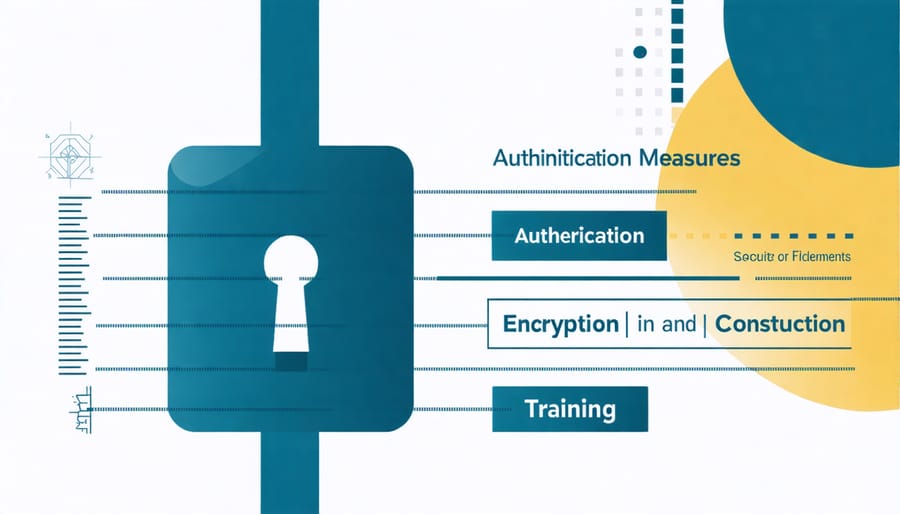Digital threats to construction operations have evolved from minor inconveniences to potentially devastating attacks that can halt multimillion-dollar projects instantly. As construction sites increasingly rely on connected devices, Building Information Modeling (BIM), and integrated project management systems, cybersecurity has become as crucial as physical security measures. Recent attacks targeting construction firms have resulted in compromised project data, stolen intellectual property, and ransomware incidents costing the industry over $5.2 billion in 2022 alone.
Modern construction projects depend on a complex digital ecosystem of IoT sensors, remote monitoring systems, and cloud-based collaboration tools – each representing a potential entry point for cybercriminals. From smart equipment tracking systems to digital twin technologies, the attack surface continues to expand. Without robust cybersecurity measures, construction companies risk not only financial losses but also schedule delays, safety incidents, and damaged client relationships.
This evolving threat landscape demands a comprehensive approach to cybersecurity that addresses both traditional IT infrastructure and construction-specific technologies. Leading firms are now implementing sophisticated security frameworks that protect everything from bid documents to building control systems, recognizing that cybersecurity is no longer optional but a fundamental requirement for modern construction operations.
The Digital Transformation of Construction Sites
Critical Digital Assets in Modern Construction
Modern construction projects rely heavily on digital assets that have become integral to project delivery and operational efficiency. Building Information Modeling (BIM) systems store valuable intellectual property, including detailed structural designs, material specifications, and project timelines. These sophisticated 3D models represent significant investments and contain sensitive competitive information that requires robust protection.
Project management platforms house critical data such as contracts, financial records, and communications between stakeholders. The interconnected nature of these systems means that a security breach could compromise entire project networks and expose confidential client information.
Internet of Things (IoT) devices and smart equipment have revolutionized construction site monitoring and management. From environmental sensors and security cameras to GPS-enabled machinery and automated systems, these connected devices generate valuable data streams. However, they also create potential entry points for cyber threats if not properly secured.
Cloud-based collaboration tools and mobile applications, while enhancing productivity and communication, introduce additional vulnerabilities that must be addressed through comprehensive cybersecurity measures. The protection of these digital assets requires a strategic approach that combines technical safeguards with proper user authentication and access controls.

Vulnerability Points in Construction Operations
Construction operations face multiple cybersecurity vulnerabilities due to the increasing integration of digital technologies. Project management platforms, Building Information Modeling (BIM) systems, and Internet of Things (IoT) devices create potential entry points for cyber threats. Cloud-based collaboration tools, while essential for modern construction projects, can become security weak spots if not properly configured and monitored.
One significant vulnerability lies in remote access systems, particularly with the rise of hybrid work environments. Construction sites often rely on mobile devices and temporary network connections, which may lack robust security protocols. Equipment tracking systems and automated machinery, connected through industrial control systems (ICS), present additional risk exposure points that require specialized digital risk management strategies.
Supply chain management systems and vendor access portals are particularly susceptible to security breaches. These systems often interface with multiple third-party vendors and subcontractors, each representing a potential security vulnerability. Additionally, building automation systems and smart construction technologies, while improving efficiency, create new attack surfaces that cybercriminals can exploit if left unprotected.
Primary Cybersecurity Threats to Construction Sites

Ransomware and Data Theft
Recent years have witnessed a surge in ransomware attacks targeting construction firms, exposing critical vulnerabilities in the industry’s digital infrastructure. These sophisticated data security threats have resulted in significant financial losses and operational disruptions.
In 2022, several high-profile construction companies fell victim to ransomware attacks, with criminals targeting project documentation, client data, and financial records. The average ransom demand exceeded $1.2 million, while total recovery costs, including system restoration and reputation management, often reached multiples of that figure.
One notable case involved a major infrastructure contractor whose Building Information Modeling (BIM) data was encrypted, halting multiple ongoing projects for weeks. The incident highlighted the interconnected nature of modern construction operations and the cascading effects of cybersecurity breaches.
Particularly concerning is the dual-threat approach adopted by cybercriminals, who now not only encrypt data but also threaten to publish sensitive information. This evolution has forced construction firms to reevaluate their backup strategies and data protection protocols. Industry experts recommend implementing robust backup systems, regular security audits, and comprehensive employee training programs to mitigate these risks.
The construction sector’s increasing reliance on cloud-based collaboration tools and digital project management systems has created new attack vectors that require constant vigilance and proactive security measures.
Supply Chain Vulnerabilities
Supply chain vulnerabilities represent a significant cybersecurity challenge in modern construction operations. The interconnected nature of construction supply chains, involving numerous vendors, contractors, and digital platforms, creates multiple entry points for cyber threats. Recent industry surveys indicate that 60% of construction companies have experienced security breaches through third-party vendors.
Construction firms frequently rely on integrated supply chain management systems to track materials, coordinate deliveries, and manage vendor relationships. These systems, while essential for efficiency, can become potential weak points if not properly secured. Common vulnerabilities include unsecured vendor portals, compromised supplier credentials, and inadequate verification processes for digital transactions.
To mitigate supply chain risks, construction companies should implement robust vendor assessment protocols and establish clear cybersecurity requirements in supplier contracts. This includes mandatory security certifications, regular security audits, and strict access control measures for shared platforms and data.
Key protective measures include:
– Implementation of multi-factor authentication for supplier portals
– Regular security assessments of third-party software integrations
– Encrypted communication channels for sensitive data transmission
– Real-time monitoring of supplier access patterns
– Comprehensive incident response plans including supplier-related scenarios
Construction firms should also maintain detailed documentation of all supply chain partners’ security protocols and establish clear procedures for handling data breaches originating from supplier networks. Regular updates and patch management across the supply chain ecosystem are crucial for maintaining robust security.

Implementing Robust Security Measures
Access Control and Authentication
Access control and authentication form the cornerstone of construction cybersecurity, particularly as digital collaboration platforms and smart construction technologies become industry standards. Implementing robust access management protocols ensures that only authorized personnel can access sensitive project data, building management systems, and digital tools.
Multi-factor authentication (MFA) should be mandatory for all user accounts, requiring at least two forms of verification before granting access to critical systems. This typically combines something users know (password), something they have (security token), and something they are (biometric data).
Role-based access control (RBAC) is essential for construction projects, allowing organizations to assign specific permissions based on job functions. For example, subcontractors might only access relevant project documents, while project managers maintain broader system privileges. Regular access audits and prompt user deactivation when staff leave the project help maintain security integrity.
Single Sign-On (SSO) solutions can streamline access while maintaining security, particularly valuable for large construction projects with multiple integrated systems. However, it’s crucial to implement strong password policies, including minimum length requirements, complexity rules, and regular password changes.
Physical access control should integrate with digital security measures, especially for construction sites utilizing IoT devices and smart building systems. This includes securing server rooms, protecting mobile devices, and controlling access to network infrastructure components.
Data Encryption and Backup Protocols
In today’s digital construction environment, protecting sensitive project data requires robust encryption and backup protocols as essential components of any construction risk management plan. Industry best practices recommend implementing AES-256 encryption for all project-related data, including blueprints, client information, and financial records, both during transmission and storage.
Construction firms should establish a multi-tiered backup system following the 3-2-1 rule: maintain three copies of critical data, store them on two different types of media, and keep one copy off-site. Cloud-based solutions with automatic encryption and versioning capabilities provide an additional layer of security while ensuring data accessibility across project sites.
Critical documentation requires end-to-end encryption, particularly when sharing through collaborative platforms. Implement role-based access controls (RBAC) to restrict data access based on job functions and project requirements. Regular backup testing and verification procedures should be conducted monthly to ensure data integrity and recovery capabilities.
For mobile devices and field equipment containing sensitive information, enable remote wiping capabilities and require encrypted local storage. Construction companies should also maintain detailed logs of all data access and modification activities, establishing a clear audit trail for security compliance and incident investigation purposes.
Employee Training and Security Awareness
Employee training is the cornerstone of effective cybersecurity in construction operations. The most sophisticated security systems can be compromised by human error, making it essential to develop a comprehensive security awareness program for all staff levels.
Start by implementing mandatory cybersecurity orientation for new hires, covering basic security protocols, password management, and data handling procedures specific to construction projects. Regular training sessions should address emerging threats, particularly those targeting Building Information Modeling (BIM) systems and project management platforms.
Create role-specific training modules that address the unique cybersecurity challenges faced by different team members. Project managers need training on secure file sharing and client data protection, while field personnel require guidance on mobile device security and proper use of IoT construction equipment.
Conduct quarterly security awareness updates through workshops, simulated phishing exercises, and hands-on training with security tools. These sessions should include real-world examples of cybersecurity incidents in construction, their impact, and preventive measures.
Establish a clear incident reporting procedure and encourage a culture where employees feel comfortable reporting potential security concerns. Implement a reward system for identifying and reporting security vulnerabilities, fostering active participation in the organization’s security efforts.
Document all training activities and maintain certification records to demonstrate compliance with industry standards and regulations. Regular assessments help measure the effectiveness of training programs and identify areas requiring additional focus.
Future-Proofing Construction Cybersecurity
Emerging Security Technologies
The construction industry is witnessing a significant transformation in cybersecurity through the integration of artificial intelligence and blockchain technologies. AI-powered security solutions are revolutionizing threat detection and response capabilities, offering real-time monitoring of construction management systems and building information modeling (BIM) platforms. These systems can identify unusual patterns in data access and user behavior, providing early warnings of potential security breaches.
Machine learning algorithms are particularly effective in analyzing vast amounts of project data to detect anomalies that might indicate cyber threats. For instance, AI systems can monitor file access patterns across multiple project sites, flagging suspicious activities that could compromise sensitive design documents or financial information.
Blockchain technology is emerging as a robust solution for securing construction project documentation and supply chain management. By creating immutable records of transactions and changes to project specifications, blockchain ensures transparency while maintaining data integrity. Smart contracts, built on blockchain platforms, are streamlining secure contract management and automated compliance verification.
Several leading construction firms have implemented distributed ledger systems to track material authenticity and maintain secure records of quality certifications. This technology not only enhances security but also improves efficiency in project documentation and stakeholder collaboration. As these technologies mature, we’re seeing increased adoption of biometric authentication systems and IoT security protocols, creating multiple layers of protection for digital assets in construction operations.
Regulatory Compliance and Standards
The construction industry faces an increasingly complex landscape of cybersecurity regulations and compliance requirements. Key frameworks such as NIST (National Institute of Standards and Technology) guidelines and ISO 27001 now directly impact construction operations, particularly in projects involving critical infrastructure or government contracts.
Construction firms must navigate multiple regulatory layers, including state-specific data protection laws, federal guidelines, and industry-specific standards. The implementation of these requirements often requires robust cybersecurity project management protocols to ensure comprehensive compliance.
Notable regulations affecting the sector include:
– CMMC (Cybersecurity Maturity Model Certification) for defense contractors
– GDPR compliance for international projects
– State-specific data privacy laws like CCPA
– Industry-specific standards such as BuildingSMART International’s security guidelines
Companies must maintain documentation of their cybersecurity measures, conduct regular audits, and implement incident response plans to meet these requirements. Failure to comply can result in substantial penalties, contract losses, and reputational damage.
Looking ahead, the regulatory landscape continues to evolve, with new standards emerging for BIM security, IoT device protection, and supply chain risk management. Construction firms should establish dedicated compliance teams and regularly update their security protocols to stay ahead of these changes.
To effectively protect digital assets in today’s construction landscape, firms must take a comprehensive approach to cybersecurity. This includes implementing robust access control systems, regularly updating software and security protocols, and conducting frequent security audits. Construction companies should prioritize employee training to create a security-conscious culture and establish clear incident response procedures. Additionally, firms must ensure proper encryption of sensitive project data, maintain secure cloud storage solutions, and regularly back up critical information. By partnering with cybersecurity experts, maintaining compliance with industry standards, and investing in modern security technologies, construction companies can significantly reduce their vulnerability to cyber threats. Remember that cybersecurity is not a one-time implementation but an ongoing process that requires constant vigilance and adaptation to emerging threats.

